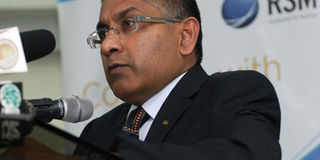Survey ranks Citi best bank in Kenya despite profit drop

RSM Group Chief Executive Ashif Kassam during a presentation for release of Kenya's banking performance in 2013 at the Jacaranda Hotel in Nairobi on April 28, 2014. Photo/SALATON NJAU
What you need to know:
- Citi Bank rides on its global brand to attract corporate clients in the local market, which has seen it record high business despite operating two branches in the country.
- Unlike Kenyan banks that have been accused of underproviding for their doubtful loans, Citi received recognition for its provision for non-performing loans.
- Bank of India was the highest mover up the ranks jumping to second from position 16 in last year’s ranking. It displaced Equity from second position to third.
Citi Bank, a branch of the US giant Citi, has been ranked the best bank in the country by audit firm RSM Ashvir despite recording a substantial 32.3 per cent drop in profit last year.
Bank of India and Equity Bank came in second and third respectively in the annual survey conducted by the consultancy major.
“Despite the profit drop it is still posting strong returns to shareholders and has well provided for its non-performing loans,” said RSM executive chairman Ashif Kassam during a briefing in Nairobi Monday.
Last year, the bank reported a net profit of Sh2.99 billion compared to 2012 earnings of Sh4.42 billion.
The plunge in earnings was accompanied by a drop in customer deposits and loans. The bank has already announced it would replace its chief executive, Daniel Connelly, in June following a four-year stint in the country.
Last year, the corporate lender laid-off some of its staff following transfer of its specialised wealth management unit. The Non Resident Indian Unit was moved to Singapore in what the bank termed as a move to more efficient ways of doing business.
Citi Bank rides on its global brand to attract corporate clients in the local market, which has seen it record high business despite operating two branches in the country.
Corporate bankers are, however, facing increasing competition within the sector as large depositors grow confidence in brands of local and smaller banks.
The smaller players are offering better prices to attract the large depositors and following a decade of stability within the industry in the wake of stringent regulatory requirement, more corporates are gaining faith in local players.
Local players have also been upping their capital base and are now able to lend large amounts to a single customer in line with central bank capital requirements.
Unlike Kenyan banks that have been accused of underproviding for their doubtful loans, Citi received recognition for its provision for non-performing loans.
Analysts have in the past noted that the banking industry was overstating its profits by underproviding for the bad loans, a point that has been dismissed by the industry arguing that their books are subjected to reputable auditors and the regulator.
Bank of India was the highest mover up the ranks jumping to second from position 16 in last year’s ranking.
It displaced Equity from second position to third. Other upward mobile institutions include UBA Bank which moved to position 17 from 25 last year despite sinking deeper into losses.




